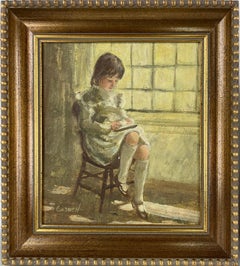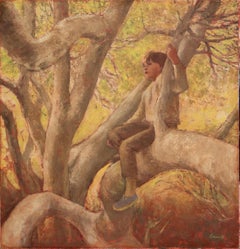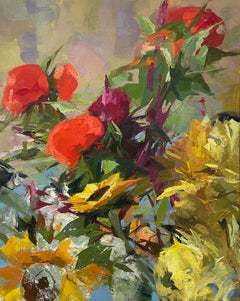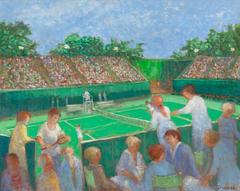Helen Rayburn Caswell Art
to
1
1
1
2
Overall Width
to
Overall Height
to
4
1
1
3
1
3
1
4
3
3
2
2
1
1
1
1
1
1
4
4
2
1
1
4
8,232
2,807
1,650
1,318
3
4
Artist: Helen Rayburn Caswell
"Boy on Carousel" large oil painting
By Helen Rayburn Caswell
Located in San Francisco, CA
This artwork "Boy on Carousel" c.1970 is an oil painting on canvas by noted California artist, Helen Rayburn Caswell, 1923-2018. It is signed at the right bottom corner by the artist...
Category
Late 20th Century American Impressionist Helen Rayburn Caswell Art
Materials
Oil
"Needle Work" Young girl by the Window original Oil on Linen
By Helen Rayburn Caswell
Located in Soquel, CA
Bright and cheery painting of a young girl by a wind by Helen Rayburn Caswell, (American, 1923 - 2018) she was born in Long Beach, California.
Image, 12"H x 11"W
Frame, 16"H x 15"W ...
Category
1980s Impressionist Helen Rayburn Caswell Art
Materials
Linen, Oil
$920 Sale Price
20% Off
'In the Sycamore', Large Figural Oil, Carmel, California Woman Artist, Muralist
By Helen Rayburn Caswell
Located in Santa Cruz, CA
Signed lower right, 'Caswell' for Helen Rayburn Caswell (American, 1923-2018) and painted circa 1955.
A substantial, mid-century figural oil by this listed California woman artist who showed her talent at an early age. In Saratoga, Caswell began a successful career as an artist and portrait painter, displaying in galleries in Carmel and teaching artist workshops. In addition to her work as a fine artist and portrait painter, Helen wrote and illustrated over 30 books for children and adults. In 1981, Helen moved to Occidental in Sonoma County where, in addition to continuing to paint and teach, she designed stained glass windows for the Sebastopol United Methodist Church. She was also commissioned to paint numerous murals including at St. Ignatius Church in San Francisco and for the Elizabeth Seton Center in Menlo Park.
Category
1950s Modern Helen Rayburn Caswell Art
Materials
Canvas, Oil
Boy Playing Cello
By Helen Rayburn Caswell
Located in San Francisco, CA
This artwork "Boy Playing Cello" c.1970 is an oil painting on canvas by noted California artist, Helen Rayburn Caswell, 1923-2018. It is signed at the right bottom corner by the arti...
Category
Late 20th Century American Impressionist Helen Rayburn Caswell Art
Materials
Oil
Related Items
"Sunflowers II", Oil Painting
Located in Denver, CO
Yana Beylinson's (US based) "Sunflowers II" is an original, handmade oil painting that depicts impressionistic flowers of red and yellow melding together with green leaves.
Artist ...
Category
2010s American Impressionist Helen Rayburn Caswell Art
Materials
Oil, Canvas
Tennis Match
By Donald S. Vogel
Located in Dallas, TX
Donald S. Vogel has been a set designer and technical director in the theater, a fine art dealer, and a writer, but first and foremost he is a painter. From a young age he was intrig...
Category
Late 20th Century American Impressionist Helen Rayburn Caswell Art
Materials
Oil, Panel
1945 American Modern Oil Painting - Portrait of Artist's Wife with Fruit
By Hayes Lyon
Located in Denver, CO
This captivating 1945 oil painting by acclaimed American artist Hayes Lyon beautifully portrays Bessy Lyon, the artist’s wife, in a warm and intimate composition. Rendered in soft ye...
Category
1940s American Modern Helen Rayburn Caswell Art
Materials
Canvas, Oil
$1,550 Sale Price
51% Off
H 35.25 in W 29.25 in D 1.75 in
20th Century Plein Air Impressionist Northern California Landscape, Farmhouse
By Jon Blanchette
Located in Denver, CO
Original Mid 20th Century Northern California Landscape Painting by Jon Blanchette (1908-1987). This vintage plein air style painting depicts a serene rural scene with a white farmho...
Category
Mid-20th Century American Impressionist Helen Rayburn Caswell Art
Materials
Oil
$1,250
H 27.5 in W 31.5 in D 1.25 in
"Mt. Evans and Bierstadt, Colorado" (2016) By David Shingler, Oil Landscape
Located in Denver, CO
David Shingler’s "Mt. Evans and Bierstadt, Colorado" (2016) is an original oil painting on wood panel, measuring 16 x 20 inches (40.64 x 50.80 cm). Known for his dynamic landscapes r...
Category
2010s American Impressionist Helen Rayburn Caswell Art
Materials
Oil, Wood Panel
American Fauvist Impressionist New England Gloucestor Fishing BOATS Painting
By Camillo Adriani
Located in New York, NY
Camillo Adriani was born in Massachusetts in the late 19th century. He studied art in Boston.
Adriani was especially well known for his vibrant portrayal of New England snow scenes...
Category
1940s American Impressionist Helen Rayburn Caswell Art
Materials
Oil
$4,250
H 30 in W 35 in D 2 in
Down River from the Pont Vecchio Bridge, Impressionism , Landscape, Plein Aire,
Located in Houston, TX
Down River from the Pont Vecchio Bridge is part of newly released small works from V....Vaughan's collection of recent travels in Italy and France. V....Vaughan painted each of the...
Category
2010s American Impressionist Helen Rayburn Caswell Art
Materials
Canvas, Oil
$825
H 6 in W 8 in D 1.5 in
The Evening Gown American Impressionism Oil on Canvas 24" x 18" Figure Interior
Located in Houston, TX
Look for Free Shipping at Checkout
The Evening Gown is an American Impressionistic painting by Stuart Fullerton. The artist is know ...
Category
2010s American Impressionist Helen Rayburn Caswell Art
Materials
Oil, Canvas
$2,200
H 24 in W 18 in D 1 in
"Amongst Aspens" (2009) By Tiffany Williams, Impressionist Oil Landscape
Located in Denver, CO
"Amongst Aspens" by Tiffany Williams is an original impressionist oil painting on panel, depicting a woman posing against an aspen tree at late afternoon in an aspen forest. This pie...
Category
Early 2000s American Impressionist Helen Rayburn Caswell Art
Materials
Oil
Pondering the Day, Oil Painting, Impressionism, LA Academy of Figurative Art
Located in Houston, TX
Pondering the Day by Vadim Zang is an oil painting that is 12" x 9". This is painted in the style of Impressionism.
Vadim Zanginian was born in Armenia in 1965. He is a graduate fr...
Category
2010s American Impressionist Helen Rayburn Caswell Art
Materials
Canvas, Oil
$1,450
H 12 in W 9 in D 1 in
"Venetian Powder Room Scene with Figures" Impressionist Oil Painting on Canvas
By Luigi Cagliani
Located in New York, NY
A whimsical oil painting depicting a Venetian Powder Room Scene with Figures getting ready for the masquerade. A truly intimate scene with a ornate mirror, flowers in a vase and whit...
Category
Early 20th Century Impressionist Helen Rayburn Caswell Art
Materials
Canvas, Oil
$4,500
H 32.5 in W 28 in D 1.5 in
Girl with Aperitivo Florence Impressionism 16 x 12 2024 Duomo
By James Crandall
Located in Houston, TX
Girl with Aperitivo No. 2
Oil on canvas panel
16” x 12”
This Florentine painting by James Crandall was painted in the summer of 2024 by the Duomo in Florence. It is oil on a cotto...
Category
2010s American Impressionist Helen Rayburn Caswell Art
Materials
Oil, Cotton Canvas, Panel
$1,600
H 16 in W 12 in D 0.75 in
Previously Available Items
Apple Bloom
By Helen Rayburn Caswell
Located in San Francisco, CA
This artwork titled "Apple Bloom" 1982 an original lithograph on paper by noted California artist, Helen Rayburn Caswell, 1923-2018. It is hand signed, titled, dated and numbered 3/2...
Category
Late 20th Century American Impressionist Helen Rayburn Caswell Art
Materials
Lithograph
Boy building a Sand Castle
By Helen Rayburn Caswell
Located in San Francisco, CA
This artwork "Boy Building a Sand Castle" c.1960 is an oil painting on canvas by noted California artist, Helen Rayburn Caswell, 1923-2018. It is signed at...
Category
Mid-20th Century American Impressionist Helen Rayburn Caswell Art
Materials
Oil
Boy Picking Flowers
By Helen Rayburn Caswell
Located in San Francisco, CA
This artwork "Boy Picking Flowers" is an oil painting on canvas by noted California artist, Helen Rayburn Caswell, 1923-2018. It is signed at the r...
Category
Late 20th Century American Impressionist Helen Rayburn Caswell Art
Materials
Oil
Saturday Afternoon
By Helen Rayburn Caswell
Located in Soquel, CA
A charming image of a once common amusement of children - running along a fence dragging a stick and enjoying the sound! By California artist Helen Rayburn Caswell (American, 1923-20...
Category
1990s Abstract Impressionist Helen Rayburn Caswell Art
Materials
Canvas, Oil
Helen Rayburn Caswell art for sale on 1stDibs.
Find a wide variety of authentic Helen Rayburn Caswell art available for sale on 1stDibs. You can also browse by medium to find art by Helen Rayburn Caswell in oil paint, paint, canvas and more. Much of the original work by this artist or collective was created during the 20th century and is mostly associated with the Impressionist style. Not every interior allows for large Helen Rayburn Caswell art, so small editions measuring 17 inches across are available. Customers who are interested in this artist might also find the work of William Frates, E. Melinda Morrison, and Marion Huse. Helen Rayburn Caswell art prices can differ depending upon medium, time period and other attributes. On 1stDibs, the price for these items starts at $375 and tops out at $5,500, while the average work can sell for $1,600.



